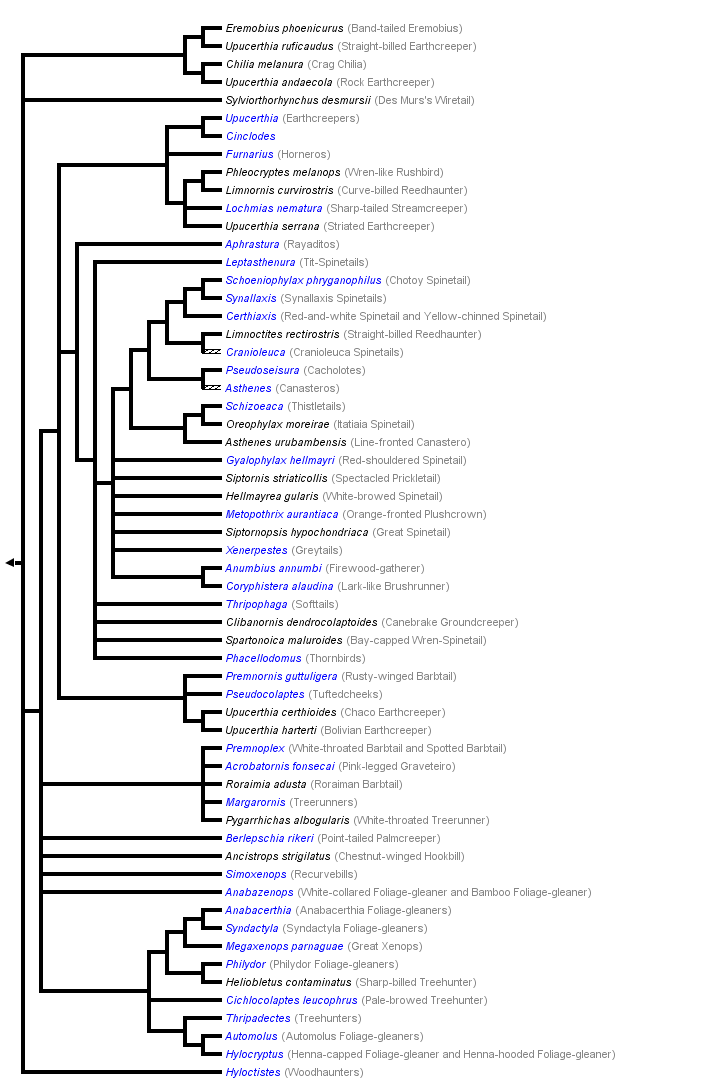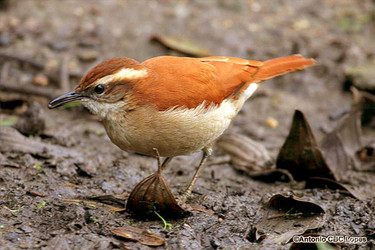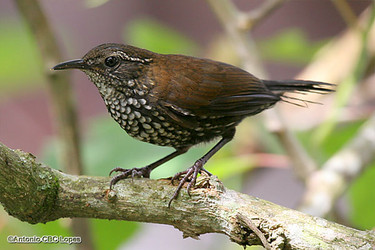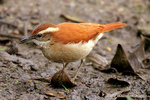Furnariidae part 2
Ovenbirds
John Harshman


This tree diagram shows the relationships between several groups of organisms.
The root of the current tree connects the organisms featured in this tree to their containing group and the rest of the Tree of Life. The basal branching point in the tree represents the ancestor of the other groups in the tree. This ancestor diversified over time into several descendent subgroups, which are represented as internal nodes and terminal taxa to the right.

You can click on the root to travel down the Tree of Life all the way to the root of all Life, and you can click on the names of descendent subgroups to travel up the Tree of Life all the way to individual species.
For more information on ToL tree formatting, please see Interpreting the Tree or Classification. To learn more about phylogenetic trees, please visit our Phylogenetic Biology pages.
close boxRelationships after Chesser et al. 2007, Fjeldså et al. 2007, Irestedt et al. 2006.
Discussion of Phylogenetic Relationships
The traditional family Furnariidae (ovenbirds) is not monophyletic, current research suggests that only four genera must be removed to make it so. The group we call here Furnariidae part 1 consists of three genera and is the sister group of all other ovenbirds and woodcreepers (Dendrocolaptidae). The single genus Xenops is the sister group of the woodcreepers. The remaining species do form a clade, here called Furnariidae part 1, but when the classification is changed to reflect phylogeny, it will be just Furnariidae.
Within Furnariidae, several genera are not monophyletic. Upucerthia (earthcreepers) is split into five parts, four of which must be renamed. Cranioleuca and Asthenes too are not monophyletic, but not enough species have been sampled to make relationships clear. Further study may reveal more non-monophyletic genera.
References
Areta, J. I. 2007. Behavior and phylogenetic position of Premnoplex barbtails (Furnariidae). Condor 109(2):399-407.
Chesser, R. T. 2004. Molecular systematics of New World suboscine birds. Molecular Phylogenetics and Evolution 32:11-24.
Chesser, R. T., F. K. Barker, and R. T. Brumfield. 2007. Four-fold polyphyly of the genus formerly known as Upucerthia, with notes on the systematics and evolution of the avian subfamily Furnariinae. Molecular Phylogenetics and Evolution 44(3):1320-1332.
Fjelds?, J., M. Irestedt, and P. G. P. Ericson. 2005. Molecular data reveal some major adaptational shifts in the early evolution of the most diverse avian family, the Furnariidae. Journal of Ornithology 146:1?13.
Fjelds?, J., M. Irestedt, K. A. J?nsson, J. I. Ohlson, and P. G. P. Ericson. 2007. Phylogeny of the ovenbird genus Upucerthia: a case of independent adaptations for terrestrial life. Zoologica scripta 36(2):133-141.
Fjelds?, J. and N. Krabbe. 1990. Birds of the High Andes. Zoology Museum, University of Copenhagen, Denmark.
Gill, F. and M. Wright. 2006. Birds of the World: Recommended English Names. Princeton NJ: Princeton University Press.
Hilty, S. 2003. A guide to the birds of Venezuela. Princeton University Press, Princeton, NJ.
Irestedt, M., J. Fjelds?, and P. G. P. Ericson. 2006. Evolution of the ovenbird-woodcreeper assemblage (Aves: Furnariidae) ? major shifts in nest architecture and adaptive radiation. Journal of Avian Biology 37:261?272.
Irestedt, M., J. Fjelds?, U. S. Johansson, and P. G. P. Ericson. 2002. Systematic relationships and biogeography of the tracheophone suboscines (Aves: Passeriformes). Molecular Phylogenetics and Evolution 23:499?512.
Olson, S. L., M. Irestedt, P. G. P. Ericson, and J. Fjelds?. 2005. Independent evolution of two Darwinian marsh-swelling ovenbirds (Furnariidae: Limnornis, Limnoctites). Ornitolog?a Neotropical 16:347?359.
Remsen, J. V. 2003. Family Furnariidae (Ovenbirds). Pages 162?357 in Handbook of the Birds of the World. Vol. 8: Broadbills to Tapaculos. J. del Hoyo, A. Elliot, and D. Christie, eds. BirdLife International and Lynx Editions, Cambridge, UK and Barcelona.
Rudge, D. W. and R. J. Raikow. 1992. Structure, function, and variation in the hindlimb muscles of the Margarornis assemblage (Aves: Passeriformes: Furnariidae). Annals of the Carnegie Museum 61:207?237.
Rudge, D. W. and R. J. Raikow. 1992. The phylogenetic relationships of the Margarornis assemblage (Furnariidae). Condor 94:760?766.
Sick, H. 1993. Birds in Brazil. A Natural History. Princeton University Press, Princeton, New Jersey.
Skutch, A. F. 1996. Antbirds and Ovenbirds. University of Texas Press, Austin, TX.
Vaurie, C. 1980. Taxonomy and geographical distribution of the Furnariidae (Aves, Passeriformes). Bulletin of the American Museum of Natural History 166:1?357.
Zyskowski, K. and R. O. Prum. 1999. Phylogenetic analysis of the nest architecture of neotropical ovenbirds (Furnariidae). Auk 116:891?911.
Title Illustrations

| Scientific Name | Furnarius figulus |
|---|---|
| Location | Brazil |
| Specimen Condition | Live Specimen |
| Source | Casaca-de-couro-da-lama |
| Source Collection | Flickr |
| ToL Image Use |
 This media file is licensed under the Creative Commons Attribution-NonCommercial-NoDerivs License - Version 2.0. This media file is licensed under the Creative Commons Attribution-NonCommercial-NoDerivs License - Version 2.0.
|
| Copyright | © 2006 Antonio CBC Lopes |
| Scientific Name | Lochmias nematura |
|---|---|
| Location | Petr?polis, Brasil |
| Specimen Condition | Live Specimen |
| Source | Jo?o-porca |
| Source Collection | Flickr |
| ToL Image Use |
 This media file is licensed under the Creative Commons Attribution-NonCommercial-NoDerivs License - Version 2.0. This media file is licensed under the Creative Commons Attribution-NonCommercial-NoDerivs License - Version 2.0.
|
| Copyright | © 2006 Antonio CBC Lopes |
About This Page
Correspondence regarding this page should be directed to John Harshman at
Page copyright © 2007
All Rights Reserved.
- First online 05 December 2007
Citing this page:
Harshman, John. 2007. Furnariidae part 2. Ovenbirds. Version 05 December 2007 (under construction). http://tolweb.org/Furnariidae_part_2/67993/2007.12.05 in The Tree of Life Web Project, http://tolweb.org/










 Go to quick links
Go to quick search
Go to navigation for this section of the ToL site
Go to detailed links for the ToL site
Go to quick links
Go to quick search
Go to navigation for this section of the ToL site
Go to detailed links for the ToL site